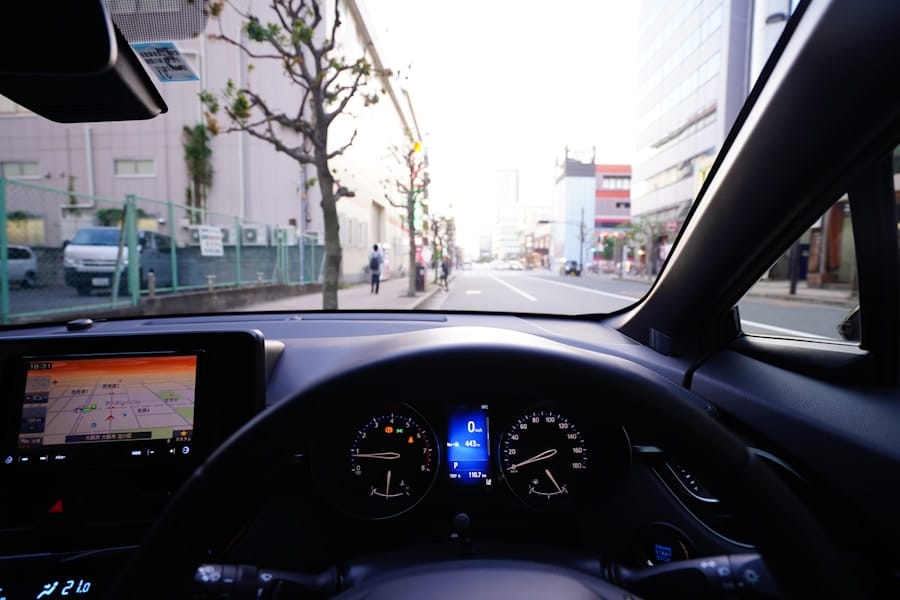The advent of 5G technology marks a significant leap in telecommunications, promising unprecedented speed, reduced latency, and enhanced connectivity. This next-generation mobile network is not merely an upgrade from its predecessor, 4G; it represents a paradigm shift that has the potential to revolutionize various sectors, including the automotive industry. Advanced Driver Assistance Systems (ADAS) are at the forefront of this transformation, integrating sophisticated technologies designed to improve vehicle safety and enhance the driving experience.
These systems utilize a combination of sensors, cameras, and artificial intelligence to assist drivers in navigating complex environments, thereby reducing the likelihood of accidents and improving overall road safety. As vehicles become increasingly equipped with advanced technologies, the need for robust communication networks becomes paramount. 5G offers a solution to this demand by providing high-speed data transfer and low-latency communication between vehicles and their surroundings.
This capability is essential for ADAS, which relies on real-time data to function effectively. The synergy between 5G and ADAS not only enhances vehicle performance but also paves the way for more sophisticated applications, such as vehicle-to-everything (V2X) communication. This integration promises to create a safer and more efficient transportation ecosystem, where vehicles can communicate with each other, infrastructure, and even pedestrians.
Key Takeaways
- 5G technology is set to revolutionize the automotive industry by enhancing vehicle connectivity and enabling advanced driver assistance systems (ADAS).
- 5G plays a crucial role in enabling real-time data processing and analysis, allowing vehicles to communicate with each other and with the surrounding infrastructure.
- V2X communication, enabled by 5G, allows vehicles to exchange information with other vehicles, pedestrians, and traffic signals, leading to improved safety and efficiency on the roads.
- 5G’s impact on autonomous driving and safety features is significant, as it enables faster and more reliable communication between vehicles and their surroundings.
- While 5G offers numerous benefits for ADAS, there are challenges and limitations that need to be addressed, such as network coverage and cybersecurity concerns.
The Role of 5G in Enhancing Vehicle Connectivity
Seamless Communication and Information Sharing
With 5G, vehicles can maintain constant communication with cloud services, other vehicles, and infrastructure elements such as traffic lights and road signs. This connectivity enables a more integrated approach to driving, where information is shared seamlessly across various platforms. For instance, consider a scenario where a vehicle equipped with ADAS approaches an intersection.
Real-time Updates and Informed Decision-Making
With 5G connectivity, the vehicle can receive real-time updates about traffic conditions, potential hazards, and even the status of traffic signals. This information allows the vehicle’s systems to make informed decisions, such as adjusting speed or changing lanes to avoid congestion or accidents. Furthermore, the high data transfer rates of 5G enable vehicles to download software updates and new features on-the-fly, ensuring that they are always equipped with the latest advancements in safety technology.
A More Efficient Transportation Network
This level of connectivity not only enhances the driving experience but also contributes to a more efficient transportation network overall.
Leveraging 5G for Real-time Data Processing and Analysis

The capabilities of 5G extend beyond mere connectivity; they also facilitate real-time data processing and analysis, which are critical for the effective functioning of ADAS. Modern vehicles generate vast amounts of data from various sensors and systems, including cameras, radar, and LiDAR.
With 5G’s low latency and high bandwidth, vehicles can transmit data to cloud-based systems for analysis almost instantaneously. For example, consider a vehicle equipped with an advanced collision avoidance system. As it navigates through traffic, it continuously collects data about its surroundings.
With 5G technology, this data can be sent to a cloud server where advanced algorithms analyze it in real-time to predict potential collisions. If a risk is detected, the system can alert the driver or even take corrective action autonomously. This capability not only enhances safety but also reduces the cognitive load on drivers, allowing them to focus more on the road ahead.
Moreover, real-time data processing enabled by 5G can also enhance predictive maintenance capabilities within ADAS. By continuously monitoring vehicle performance and analyzing data trends, manufacturers can identify potential issues before they become critical problems. This proactive approach not only improves vehicle reliability but also reduces maintenance costs for consumers.
Advancements in V2X Communication Enabled by 5G
Vehicle-to-everything (V2X) communication is a cornerstone of modern automotive technology that encompasses communication between vehicles (V2V), vehicles and infrastructure (V2I), and vehicles and pedestrians (V2P). The integration of 5G technology into V2X communication systems represents a significant advancement in how vehicles interact with their environment. With its high-speed data transfer capabilities and ultra-reliable low-latency communication (URLLC), 5G enables vehicles to share information with one another and their surroundings in real-time.
For instance, in a V2V scenario, two vehicles approaching an intersection can communicate their speeds and trajectories to each other via a 5G network. This exchange of information allows both vehicles to make informed decisions about whether to proceed or yield at the intersection, significantly reducing the risk of collisions. Similarly, V2I communication allows vehicles to receive updates from traffic management systems about road conditions or upcoming hazards, enabling them to adjust their routes accordingly.
Furthermore, V2P communication enhances pedestrian safety by allowing vehicles to detect nearby pedestrians and alert drivers in real-time. For example, if a pedestrian is about to cross the street at an intersection, a connected vehicle can receive this information through a 5G network and take necessary precautions to avoid an accident. This level of interaction between vehicles and their environment creates a more cohesive transportation ecosystem where safety is prioritized.
5G’s Impact on Autonomous Driving and Safety Features
The integration of 5G technology into autonomous driving systems is poised to redefine the landscape of road safety and efficiency. Autonomous vehicles rely heavily on real-time data from various sources to navigate complex environments safely. With 5G’s capabilities, these vehicles can access vast amounts of information almost instantaneously, allowing them to make informed decisions in dynamic situations.
For example, consider an autonomous vehicle navigating through a busy urban environment. With 5G connectivity, it can receive real-time updates about traffic patterns, road closures, and even weather conditions from cloud-based services. This information enables the vehicle’s AI algorithms to optimize its route dynamically, ensuring that it avoids congested areas or hazardous conditions.
Additionally, the low latency of 5G allows for rapid communication between multiple autonomous vehicles on the road, facilitating coordinated maneuvers that enhance safety. Moreover, 5G technology enhances safety features within autonomous driving systems by enabling advanced sensor fusion techniques. By combining data from various sensors—such as cameras, radar, and LiDAR—autonomous vehicles can create a comprehensive understanding of their surroundings.
With 5G’s high-speed data transfer capabilities, this sensor data can be processed in real-time, allowing for more accurate object detection and classification. As a result, autonomous vehicles can respond more effectively to potential hazards, further improving safety on the roads.
Overcoming Challenges and Limitations of 5G in ADAS

Despite its numerous advantages, the implementation of 5G technology in Advanced Driver Assistance Systems is not without challenges. One significant hurdle is the need for extensive infrastructure development to support widespread 5G coverage. While urban areas may benefit from robust 5G networks due to higher population density and demand for connectivity, rural regions may lag behind in terms of access to this technology.
This disparity could create challenges for ADAS features that rely on consistent connectivity across different environments.
As vehicles become more interconnected through V2X communication systems, they become potential targets for cyberattacks.
Ensuring robust cybersecurity measures are in place is crucial to protect sensitive data and maintain user trust in these technologies. Manufacturers must invest in developing secure communication protocols and encryption methods to safeguard against potential threats. Furthermore, regulatory frameworks surrounding autonomous driving and connected vehicle technologies are still evolving.
Policymakers must establish clear guidelines that address liability issues in case of accidents involving autonomous vehicles or those utilizing ADAS features powered by 5G technology. The lack of standardized regulations could hinder innovation and slow down the adoption of these advanced systems.
Future Possibilities and Innovations in 5G-powered ADAS
The future possibilities for 5G-powered Advanced Driver Assistance Systems are vast and exciting. As technology continues to evolve, we can expect innovations that further enhance vehicle safety and efficiency. One potential area of development is the integration of artificial intelligence (AI) with 5G networks to create smarter ADAS solutions.
By leveraging machine learning algorithms alongside real-time data from connected vehicles and infrastructure, manufacturers could develop systems capable of predicting driver behavior and adapting accordingly. Another promising avenue is the expansion of V2X communication capabilities beyond traditional applications. For instance, future developments may include enhanced interactions between vehicles and smart city infrastructure.
Imagine a scenario where traffic lights communicate directly with approaching vehicles via a 5G network to optimize traffic flow based on real-time conditions. Such innovations could significantly reduce congestion and improve overall urban mobility. Moreover, as autonomous driving technology matures alongside 5G advancements, we may witness the emergence of fully autonomous fleets operating seamlessly within urban environments.
These fleets could utilize V2X communication to coordinate movements efficiently while prioritizing passenger safety. The integration of advanced analytics powered by AI could enable these fleets to learn from their experiences on the road continuously.
The Promising Future of 5G in Driving Safety and Efficiency
The integration of 5G technology into Advanced Driver Assistance Systems heralds a new era in automotive innovation that prioritizes safety and efficiency on our roads. By enhancing vehicle connectivity through high-speed data transfer and low-latency communication capabilities, 5G empowers ADAS features that significantly reduce accident risks while improving overall driving experiences. As we continue to explore the potential applications of this transformative technology—from real-time data processing to advanced V2X communication—the future looks promising for both drivers and pedestrians alike.
While challenges remain regarding infrastructure development, cybersecurity concerns, and regulatory frameworks surrounding connected vehicles, ongoing advancements in technology will likely address these issues over time. The collaboration between automotive manufacturers, telecommunications providers, policymakers, and researchers will be crucial in shaping a future where 5G-powered ADAS becomes an integral part of our transportation ecosystem—ultimately leading us toward safer roads and more efficient mobility solutions for all.
If you’re interested in the latest technology trends, you may also want to check out this article discussing the top trends on LinkedIn for 2023. It provides insights into the most popular topics and discussions happening on the professional networking platform. This article can give you a broader perspective on the advancements in technology and how they are shaping various industries, including the automotive sector with the integration of 5G technology in advanced driver assistance systems.
FAQs
What is 5G?
5G is the fifth generation of wireless technology for digital cellular networks. It promises faster speeds, more reliable connections, and lower latency than its predecessors.
What are Advanced Driver Assistance Systems (ADAS)?
Advanced Driver Assistance Systems (ADAS) are electronic systems that aid drivers in the driving process. They can provide features such as adaptive cruise control, lane departure warning, and automatic emergency braking.
How does 5G power Advanced Driver Assistance Systems?
5G enables ADAS to access and process large amounts of data in real time. This allows for faster and more accurate decision-making by the ADAS, leading to improved safety and performance.
What are the benefits of using 5G for ADAS?
The use of 5G for ADAS allows for faster communication between vehicles and infrastructure, improved accuracy of sensor data, and enhanced capabilities for autonomous driving features.
Are there any challenges in implementing 5G for ADAS?
Challenges in implementing 5G for ADAS include the need for widespread 5G network coverage, ensuring data security and privacy, and addressing potential regulatory and standardization issues.

